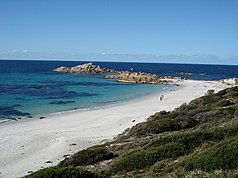Mount William National Park
| Mount William National Park | ||
|---|---|---|
| Stumpys Bay Beach | ||
|
|
||
| Location: | Tasmania , Australia | |
| Specialty: | Coastal landscape | |
| Next city: | Launceston (Tasmania) | |
| Surface: | 184.39 km² | |
| Founding: | 1973 | |
| Address: |
William National Park via St Helens Field Office PO Box 353 St. Helens TAS 7216 |
|
The Mount William National Park (English: Mount William National Park ) is a national park in the northeast of the Australian state of Tasmania . It is 17 km east of Gladstone .
The national park is characterized by its long, secluded sandy beaches and low mountain ridges. It plays an important role in the preservation of the coastal heathland and hardwood vegetation . The heather stands dominate on the poorer soils. The highest point is Mount William at 216 m.
Flora
The park has a diverse flora. Hundreds of different species have been identified so far. In spring and summer, the plants impress with their abundance of flowers. Many plants in the park depend on regular fires for stand regeneration. The sand dunes are the habitat of succulent climbing plants and specialized grasses. Behind the dunes are z. Sometimes flooded areas and myrtle heather swamps. These biotopes dry out in summer and then fill up with water again in the wet season. Common tree species are the black eucalyptus (Eucalyptus amygdalina), Eucalyptus ovata and banksia . In addition, the conspicuous grass trees are a common type of wood in the national park.
Wildlife
The national park was created in 1973 to protect the threatened Forester kangaroo . In the park you can u. a. Watch red-necked wallabies , wombats and red-bellied filanders. The Tasmanian Devil is also found in the area, but is difficult to spot because of its nocturnal way of life.
About 100 bird species have been observed in the park, including the Goldflügel- honeyeater ( Phylidonyris pyrrhopterus ), the gold crown honeyeater ( Gliciphila melanops ), the splendor wren ( Malurus cyaneus ), striated pardalote ( Pardalotus striatus ) and the famous Jägerliest ( Laughing Kookaburra ) . Seagulls, terns, gannets and albatrosses can also be seen along the coast.
See also
Web links
- official site of the park (Engl.)
Individual evidence
- ↑ General information from the National Park Administration , engl.
- ↑ Information on the plant species , engl.
- ↑ a b Notes on the animal world

